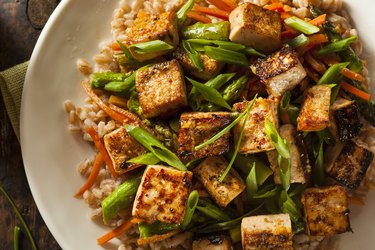
Whether you're trying to eat more vegetarian proteins or you've recently started a plant-based diet, it can be intimidating to navigate your options. Is tofu better for you than seitan? Is it really healthy to eat soy — and what can you eat when you're tired of soy-based foods?
Not to worry: Anyone who's vegetarian, vegan or mostly plant-based has been in your shoes, and all it takes is a little know-how and some trial and error with recipes to become a pro with these options. Start by learning the nutritional highlights, health benefits and recommended uses for these plant-based protein options, and then have fun as you see what you like best.
1. Tofu
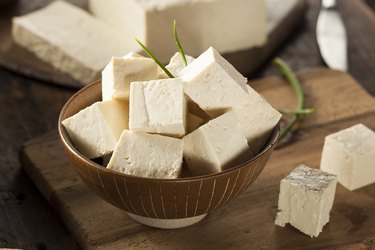
Also called bean curd, tofu is made by taking soymilk, curdling it and forming it into blocks — kind of similar to how dairy milk is formed into cheese.
Depending on how it's made, the texture can be silky, soft, firm or extra-firm, and you can also find sprouted tofu, made with sprouted soybeans, which is easier to digest but higher in fat and calories.
Tofu Nutrition and Health Benefits
"Tofu has a great mix of nutrients including protein, healthy fats, fiber, phytochemicals called isoflavones, omega-3 fatty acids and even calcium, selenium and iron," says Lindsey Pine, RDN, and owner of TastyBalance Nutrition.
However, the exact nutritional values depends on how the tofu is prepared, so check labels if you are concerned about a specific nutrient.
A 3.5-ounce serving of soft tofu has:
- 71 calories
- 4 grams of fat
- 1.2 grams of carbs (1.2 grams of fiber)
- 6 grams of protein
A 3.5-ounce serving of firm tofu has:
- 88 calories
- 4.4 grams of fat
- 2.2 grams of carbs (2.2 grams of fiber)
- 9.9 grams of protein
A 3.5-ounce serving of extra-firm tofu has:
- 94 calories
- 4.7 grams of fat
- 3.2 grams of carbs (1.2 grams of fiber)
- 9.4 grams of protein
To compare that to other protein sources, "three ounces of tofu provides about as much protein as an ounce of chicken and a little more than a boiled egg," says New York City-based nutrition expert Samantha Cassetty, RD.
Tofu is a complete protein, meaning it provides all of the essential amino acids we need to get from our diet. Our body uses these to build proteins to perform important bodily functions.
Most versions of tofu also provide about 20 percent of the recommended daily calcium to help support bone health and about 6 percent of the recommended daily iron to support growth and development. Firm and extra-firm tofu are excellent sources of calcium, providing more than softer forms of tofu.
Beyond these tofu nutrients, there has been some confusion about the connection between soy foods and different health benefits.
Compounds in soy (such as isoflavones) appear to improve blood pressure, glycemic control, obesity and inflammation, according to an April 2017 review published in the journal Nutrients.
And because soy contains two isoflavones — genistein and daidzein — that act like estrogen within the body, there have also been concerns that it could raise the risk of breast cancer and other hormone-dependent cancers, Cassetty says.
"However, these fears have been put to rest, and the American Institute for Cancer Research considers moderate amounts of soy protein like tofu safe, even for breast cancer survivors," she says.
One drawback of soy, however, is that it is one of the top allergens, so make sure that no one in your household is allergic.
How to Cook Tofu
Tofu is a blank slate and will take on whatever flavors you cook with it. It can be used for savory or sweet dishes, and each texture is best for different recipes:
- Silken
and soft tofu is great for smoothies, dips, creamy dressings and
puddings or mousse.
- Firm
tofu crumbles when you cook it, making it good for filling tacos or
as a replacement for scrambled eggs, Cassetty says, like in this Veggie Tofu Scramble.
- Extra-firm tofu can be cubed and cooked in stir-fries and on kebabs or baked and added to salads and grain bowls. Try our Tofu Tricolor Stir-Fry for dinner.
- Pine suggests rubbing the block
of extra-firm tofu with spices and barbecuing it whole on the grill.
For any tofu recipes, be sure to press and drain the tofu before preparing it. Tofu is typically sold in water and can retain this moisture. If you cook it as it comes, you can wind up with a watery, less flavorful final dish.
To press the tofu, remove the block from the packaging and line a plate or cutting board with paper towels. Place the tofu on top and layer some paper towels on top of that. Then add a heavy plate, pan or cans on top. Let this sit for 30 minutes to an hour, then toss the paper towels and your tofu is ready to use.
Read more: 10 Recipes You Can Make With or Without Meat
2. Tempeh
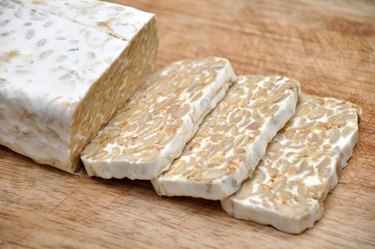
Another soy food, tempeh is formed from whole soybeans that are cooked and fermented, Pine says. Some brands add cooked grains or seeds to the soybeans. Compared to tofu, tempeh has a firmer texture and a somewhat nutty flavor.
Tempeh Nutrition and Health Benefits
"Tempeh contains healthy fats, iron, calcium, niacin and omega-3s and contains more protein than tofu," Pine says. It also has more carbohydrates and fiber than tofu does.
3.5 ounces of tempeh provides:
- 192 calories
- 9 grams of fat (2.5 grams of saturated fat)
- 7.6 grams of carbs
- 17 grams of protein
Because it's also made from soy, tempeh has similar health benefits as tofu does. "And since it is made from fermented soybeans, it contains probiotics, which may be beneficial for digestive health," Pine says.
These benefits aren't limited to tempeh alone, though. A November 2016 review in the Journal of Agricultural and Food Chemistry found that eating any soy foods may cause beneficial changes to our gut bacteria that may reduce the risk of diseases and benefit our health.
The study authors also found that fermented soy foods have both prebiotic and probiotic effects on the gut bacteria, but more research is necessary to determine what, if any, health benefits this leads to.
How to Cook Tempeh
Similar to tofu, tempeh can be grilled, baked, stir-fried, crumbled like ground meat and used in sandwiches. "I recommend marinating the tempeh or adding a sauce to give it more flavor," Pine says. "It pairs very well with flavorful marinades that include soy sauce, ginger, garlic and orange juice. And grilled or baked tempeh with low-sugar barbecue sauce is a tasty option."
Because tempeh's earthy flavor can be strong for those new to tasting it, some recommend steaming it for about 10 to 15 minutes before preparing it, which can help mellow out the flavor.
You can also try one of these tasty recipes:
3. Seitan

A soy-free option, seitan is pure wheat gluten. It has a meaty texture and can be sold plain or made into bacon, sausages, burgers and other meat alternatives.
Seitan Nutrition and Health Benefits
"Since all of the starch has been washed away during the production of seitan, it is a low-carbohydrate food that is high in protein. It also contains minerals, such as iron, selenium and calcium," Pine says.
The exact nutritional values vary from brand to brand, but 3.5 ounces of seitan generally provides:
- 143 calories
- 2.4 grams of fat
- 12 grams of carbs (1.2 grams of fiber)
- 19 grams of protein
There aren't any studies on seitan, but it's a good plant-based protein for people who are allergic to soy, Pine says. However, "if you have celiac disease or must avoid gluten due to other medical issues, do not eat seitan because it is made of wheat gluten," she says.
Read more: 12 Tips to Getting a Vegetarian Diet Right
How to Cook Seitan
Seitan can be marinated, sautéed, grilled, stir-fried or baked. You can use it in sandwiches, fajitas, chili or even as a fillet like a piece of meat. "Seitan is very forgiving. It's pretty hard to mess it up!" Pine says. So experiment and have fun.
4. Quinoa
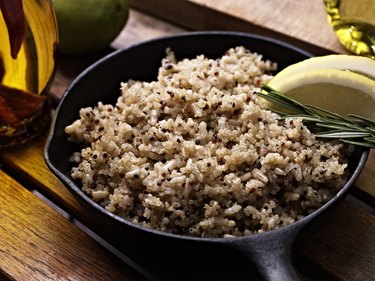
You're probably used to thinking of quinoa as a grain. Technically, it's a seed, says Randy Evans, RD, LD, a consultant with Fresh n' Lean. Sometimes, it's referred to as a pseudo-cereal, per the Whole Grains Council.
Quinoa — and other seeds such as chia or hemp seeds — are a rich source of fiber, as you'd expect from something so hearty, but also offer up a significant amount of protein. Quinoa is available in several different colors (red, white, yellow and black). It's chewy and has a slightly nutty flavor to it.
Quinoa Nutrition and Health Benefits
Because quinoa is high in carbohydrates, people don't typically use it as a single source of protein, says Evans. Instead, quinoa can be just one of the many protein sources throughout a day which in total will get you the protein you need.
Unlike many other plant-based sources of protein, quinoa supplies all of the essential amino acids. That makes it a complete protein, "which is important for people who cut out meat," says Evans. And, it's full of fiber as well as important vitamins and minerals (like folate, magnesium, manganese and iron), he adds.
One cup of cooked quinoa has:
- 222 calories
- 3.53 grams of fat
- 39.2 grams of carbs (5.2 grams of fiber)
- 8.1 grams of protein
Because quinoa is gluten-free, it's great for people avoiding gluten due to gluten intolerance or celiac disease. (Always check the package, however, to make sure that the grain is not packed in a factory with items that have gluten.)
And despite being high in carbs, quinoa is pretty low on the glycemic index (GI), with a score of 53 out of 100, which means it is less likely to spike your blood sugar drastically.
How to Cook Quinoa
The process for cooking quinoa is similar to cooking rice, says Evans. Rinse it first to remove the bitter taste that comes from its outer coating, known as saponin. Then cook until its tender but still firm, he recommends.
"Quinoa is so versatile because it easily takes on the flavor of anything you put it with," Evans says.
You can add it to salads to make them more energy-dense, or add it to a soup that needs to simmer for awhile, Evans suggests. (If you're adding this seed to soup, you may need to add additional water as well.) You can also use it in place of oatmeal, he suggests.
Try quinoa in these delicious recipes:
5. Pulses

The edible seed of a legume plant, pulses are all an affordable form of protein, says Elizabeth Huggins, RDN, with Hilton Head Health.
There are hundreds of pulses available around the world, according to the Global Pulse Confederation. Some of the most familiar ones are likely lentils, chickpeas, split peas and dry beans (such as black beans, kidney beans and navy beans). You can eat beans as-is from a can, or cook dried ones from scratch if time permits.
Chickpea, Lentil and Beans Nutrition and Benefits
The nutritional value varies from one pulse to another. All of them have certain nutritional qualities in common: "They are rich in soluble fiber, folic acid and are an incredibly versatile and sustainable food," Huggins says.
Beans are a good source of fiber and iron, says Amy Shapiro, RD, CDN, founder and director of Real Nutrition and a nutritionist with Daily Harvest.
3.5 ounces of canned chickpeas contains:
- 138 calories
- 3 grams of fat
- 21 grams of carbs (7 grams of fiber)
- 7.7 grams of protein
3.5 ounces of cooked lentils provides:
- 115 calories
- 0.4 grams of fat
- 20 grams of carbs (8 grams of fiber)
- 8.9 grams of protein
3.5 ounces of cooked black beans contains:
- 132 calories
- 0.5 grams of fat
- 23.7 grams of carbs (8.7 grams of fiber)
- 8.9 grams of protein
The Food and Agriculture Association of the United Nations, which declared 2016 the "year of the pulse" notes that they're high in cholesterol-lowering fiber, are a solid source of potassium, are naturally gluten-free and are also low-glycemic index foods. Plus, pulses are easy to access and very affordable.
Read more: What Pulses Are and Why You Should Be Eating Them
How to Cook Pulses
To cook dry beans, you will typically need to soak them overnight (or, boil them briefly, let them sit for an hour and then drain the water). Easier still is to purchase beans, which are readily available as a cooked and canned food. If you buy them canned, ust remember to rinse them well before you use them to get rid of some of the sodium.
"Beans can simply be added to any meal as a curry or tossed on a salad, can be easily added to soup, made into veggie burgers and used in the place of meat in tacos, too," says Shapiro. There are so many ways to use them, you could never get bored of beans.
Get more ideas for how to use pulses with these LIVESTRONG.com recipes:
6. Textured Vegetable Protein (TVP)
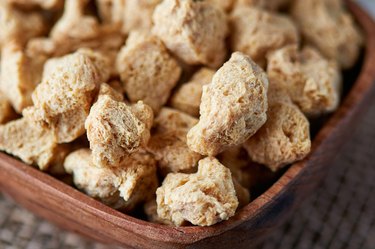
This complete source of vegan protein is "made from the part of the soy bean that is left over after soybean oil is extracted," says Shapiro. It was invented in the 1960s, and its generic name is textured soy protein (TSP). "You can buy it is a block or as a dry product you can reconstitute with water," she notes.
That might not sound very appetizing, but when it's cooked, TVP has a ground beef-like texture — so if you've been missing meat chili, pasta Bolognese, sloppy joes or other dishes where ground beef is a star, you might appreciate a block of this protein.
Textured Vegetable Protein Nutrition and Health Benefits
Not surprisingly, TVP is a protein powerhouse. Along with being protein-rich, TVP is also high in fiber. And, importantly, it's a good source of iron, a nutrient that many vegans and vegetarians require," says Shapiro.
3.5 ounces of TVP contains:
- 327 calories
- 1.2 grams of fat
- 34 grams of carbs (17.5 grams of fiber)
- 51.5 grams of protein
The biggest perk of TVP is that it is a complete protein, so it contains all the essential amino acids.
How to Cook TVP
Typically, you'll need to reconstitute TVP in hot water. Since it's flavorless, you can add it to any number of savory dishes, where it will then take on the taste of what it cooks with, as tofu does. Try adding it to soups and stews, for instance, or use it in tacos.
You can purchase TVP from brands such as Bob's Red Mill, Hoosier Hill Farm and Anthony's.
7. Mushrooms
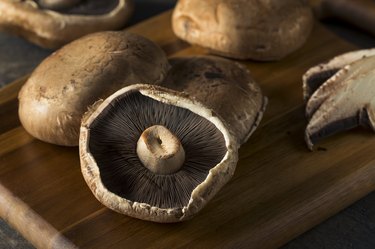
Most people have strong feelings about mushrooms — this umami-rich vegetable is a divider, not a uniter, as anyone collecting topping ideas for pizza is well aware of. Mushrooms are a whole food, says Shapiro, which makes them a great meat alternative.
Mushroom Nutrition and Health Benefits
Mushrooms are high in fiber, but low in calories. Plus, they're a great source of many vitamins and minerals, says Shapiro. This includes magnesium, zinc and B vitamins such as folate.
"Zinc is an important nutrient that many vegans and vegetarians are deficient in," says Shapiro. Mushrooms also contain selenium, which is an essential mineral that keeps your reproduction and thyroid hormone metabolism healthy, according to the National Institutes of Health.
One cup of raw, sliced mushrooms contains:
- 15 calories
- 0.2 grams of fat
- 2.2 grams of carbs (0.7 grams of fiber)
- 2 grams of protein
Compared to other options on this list, mushrooms do not have a lot of protein. However, their taste makes them a good substitute, and including the fungi alongside other more protein-rich options will add to a satisfying meal.
For thousands of years, people have been eating mushrooms — and also using them medicinally. There have been many exciting preliminary studies into the health benefits for mushrooms. For instance, a March 2019 study in the Journal of Alzheimer's Disease found a link between consuming mushrooms and reduced risk of mild cognitive impairment.
How to Cook Mushrooms
Let us count the ways! Chop mushrooms up and add them to a pasta sauce or stir fry. They're a nice addition to salads, and can be used in place of meat in tacos and veggie burgers.
"Mushrooms can substitute as meat simply by grilling them," says Shapiro. (Portobellos are a particularly nice grilling option.) And, you can also easily cook mushrooms in the oven. You can cook them with onions, then pulverize the mix in the food processor to make vegetarian chopped liver, or make a meat-free mushroom stroganoff.
Try the fungi in these mushroom recipes:
8. Jackfruit

This large fruit, with a golden-hued inside, can weigh between 10 and 60 pounds, according to the University of Florida Extension.
The outside of the fruit is rough and thick, but the inside contains edible seeds and pulp, which the University of Florida Extension describes as "sweet, aromatic, crispy, soft or melting." Jackfruit's texture, says Shapiro, makes it a great substitute for meat.
Jackfruit Nutrition and Health Benefits
"Jackfruit contains many antioxidants including vitamin C, carotenoids and flavonoids. It also has 3 grams of protein per serving and is a great source of fiber," says Shapiro.
3.5 ounces of jackfruit provides:
- 95 calories
- 0.64 grams of fat
- 23.2 grams of carbs (1.5 grams of fiber)
- 1.7 grams of protein
As with mushrooms, jackfruit provides a chewy, meat-like experience but does not have high levels of protein. Combine it with other protein sources — such as beans or soy — to bump up the protein levels.
One extensive analysis of jackfruit, published in January 2019 in the International Journal of Food Science, found that it contains phytonutrients that are linked to anticancer, antihypertensive, antiulcer and antiaging properties, and that the fruit may help reduce diseases such as bone loss, high blood pressure and heart disease.
How to Cook Jackfruit
While you can purchase your own fruit and carve it up, and easier — and likely faster — option is to purchase canned jackfruit. Then, try using it as a substitute for meat in tacos or in pulled pork sandwiches, suggests Shapiro.
Read more: How to Cook Jackfruit
The Best Meat Substitutes to Buy
As well as options you can prepare yourself, there are also many products that you can purchase in your supermarket. These can be especially handy if you are first transitioning away from meat, and struggle to think in terms of protein without fish, chicken, beef or pork on your plate.
Be aware, however, that these foods are processed and often contain many ingredients, says Shapiro. On the plus side, she says, they're often derived from soy (making them a complete protein) or pea (not a complete protein, but a solid source of it). Since they're made with a processed form of soy, some of soy's health benefits are lost, she says.
"I recommend enjoying these foods in moderation," Shapiro says. If you're looking for a fast kitchen short-cut, here are some of the available options.
1. Boca
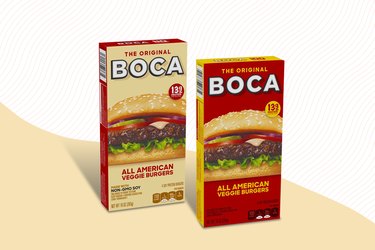
As well as burgers, Boca makes veggie crumbles — which is ideal for in soups and sauces — and faux chicken nuggets. Note that while all of Boca's products are vegetarian, not all are vegan — so read labels carefully if you adhere to that diet. Most Boca products are made primarily with soy.
One serving of Boca's All-American Veggie Burger contains:
- 200 calories
- 8 grams of fat (2.5 grams of saturated fat)
- 11 grams of carbs (7 grams of fiber)
- 24 grams of protein
Buy it: Amazon.com; Price: $3.22 per 4-count
Some Boca products available for purchase are: Boca Original All American Frozen Veggie Burgers and Boca Original Chik'n Frozen Vegan Protein Patties.
2. Beyond Meat
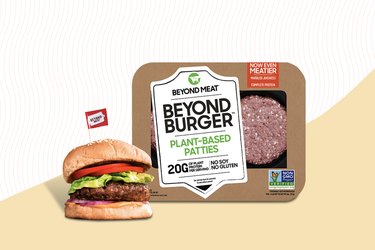
Products from Beyond Meat, such as the Beyond Burger have been getting a lot of attention for their ability to replicate the experience of eating meat — from taste to texture — in a way that feels uncanny.
As well as being available for purchase, this burger is also sold at many restaurant chains. Unlike most meat substitutes, Beyond Meat is stocked in the meat aisle (not the freezer aisle) in grocery stores.
The Beyond Burger is made from pea protein, and contains no gluten or soy. A patty contains:
- 250 calories
- 18 grams of fat (6 grams of saturated fat)
- 3 grams of carbs (2 grams of fiber)
- 20 grams of protein
Buy it: Amazon.com; Price: $5.99 per pack
3. Gardein
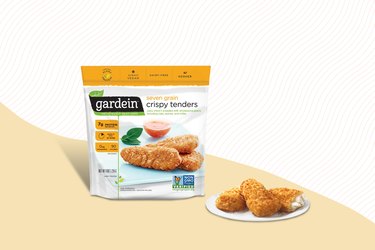
You'll find Gardein's "Meatless Meats" — such as the Ultimate Beefless Ground, Gardein Golden Fishless Filets and Gardein Seven Grain Crispy Tenders — available online and at groceries. These products are soy-based and vegan.
One serving of the tenders (three pieces) contains:
- 140 calories
- 6 grams of fat (0.5 grams of saturated fat)
- 12 grams of carbs (<1 grams of fiber)
- 11 grams of protein
Buy it: Amazon.com; Price: $4.69 per 9-ounce bag
4. MorningStar Farms
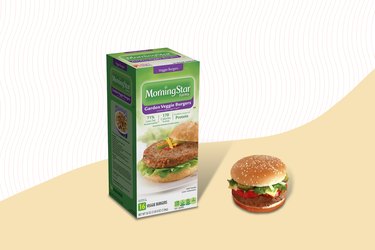
Like Gardein, MorningStar Farms offers soy-based products that are widely available in grocery stores in the frozen aisle. Their products include Original Chik Patties, Grillers Crumbles and Garden Veggie.
One serving of a MorningStar Farms Garden Veggie Burger contains:
- 110 calories
- 4.5 grams of fat (0.5 grams of saturated fat)
- 9 grams of carbs (4 grams of fiber)
- 11 grams of protein
Buy it: Amazon.com; Price: $3.69 per 4-pack